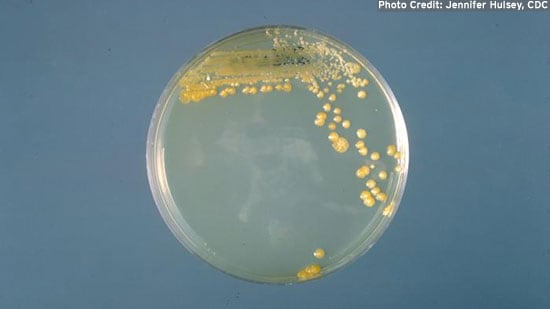
Cronobacter sakazakii
WHAT IS CRONOBACTER SAKAZAKII?
Cronobacter sakazakii is a bacterium within the family Enterobacteriaceae. The organism was called "yellow-pigmented Enterobacter cloacae" until 1980, when it was renamed Enterobacter sakazakii. Recently, E. sakazakii has been re-classified as 6 species within the genus Cronobacter.1 All of these organisms cause a rare infection, primarily in low birth weight neonates (newborn children, less than two months old) who are immunocompromised. A review article summarizing literature from 1960 through 1999 revealed only 31 cases in neonates, infants and children.2 In subsequent years, only a few more cases were observed. Infection has most commonly been associated with consumption of contaminated infant formula subjected to temperature abuse.
WHAT ARE THE SYMPTOMS OF CRONOBACTER SAKAZAKII?
Symptoms of Cronobacter sakazakii include poor feeding response, irritability, jaundice, grunting respirations and unstable body temperature, with infection progressing to meningitis in many neonatal cases. Death has been reported in up to 50 percent of neonatal patients, occurring within a few hours to several days. Surviving infants may experience neurological impairment and central nervous system infection. Recently, the emergence of antibiotic-resistant strains has been observed.
HOW IS CRONOBACTER SAKAZAKII TRANSMITTED?
The primary source of the organism and the main vehicle for Cronobacter sakazakii transmission is rehydrated powdered infant formula.3 C. sakazakii has been found at low levels (typically ≤3 organisms per 100 grams) in samples of infant formula powders.4 Time-temperature abuse of prepared formula causes low levels of contaminants to increase with potential to cause illness. However, low populations have been shown to cause illness even in the absence of abuse after preparation.
Post-process contamination of the formula powder is considered a likely source of the organism, since the usual pasteurization treatments given to the milk in the production process are adequate to destroy C. sakazakii.5 However, some formula products with added ingredients may be produced via dry blending, without a heat step. The organism has been isolated from a broad variety of production facilities.6
HOW IS CRONOBACTER SAKAZAKII CONTROLLED?
Powdered infant formula manufacturers are encouraged to work with their suppliers to ensure the microbial quality of ingredients used in formula production, and that the appropriate food safety systems (e.g., HACCP) are in place. Additionally, effective sanitation in the production facility can reduce overall environmental contaminants, including Cronobacter spp, which in turn should reduce the incidence in the finished product.
Using hot water to reconstitute dry powder formula can reduce or eliminate C. sakazakii. More than a 4-log reduction in the level of contaminating C. sakazakii in formula was seen when hydrating water was >70°C (158°F).7 However, hot water reconstitution has the potential to destroy some nutrients. Consultation with infant nutritional experts is recommended. An FAO technical meeting held in 2006 highlighted the possible need for label changes to ensure that preparation of powdered infant formula minimizes risk from C. sakazakii.8
As a result of a death attributed to formula believed to be contaminated with C. sakazakii, the CDC9 recommended the following practices to reduce the risk of further illness:
- Choose alternatives to powdered forms when possible since powder is not commercially sterile. Liquid, ready-to-feed formula is commercially sterile.
- Prepare powdered formula under aseptic technique in a designated preparation room.
- Follow manufacturer's instructions. Product should be refrigerated immediately and discarded if not used within 24 hours of preparation.
- Limit the administration or "hang-time" for continuous enteral feeding to 4 hours or less.
Since it has been shown that one contaminating cell has the potential to grow and cause illness, it would be prudent to implement a combination of risk-reduction measures to effectively manage the hazard. A joint meeting of the FAO and WHO developed similar recommendations after conducting a quantitative risk assessment for E. sakazakii (Cronobacter spp.) in powdered infant formula.10
REFERENCES AND FURTHER INFORMATION
1Iversen, C; Mullane, N; McCardell, B; D. Tall, B; Lehner, A; Fanning, S; Stephan, R and Joosten, H. 2008. Cronobacter gen. nov., a new genus to accommodate the biogroups of Enterobacter sakazakii, and proposal of Cronobacter sakazakii gen. nov., comb. nov., Cronobacter malonaticus sp. nov., Cronobacter turicensis sp. nov., Cronobacter muytjensii sp. nov., Cronobacter dublinensis sp. nov., Cronobacter genomospecies 1, and of three subspecies, Cronobacter dublinensis subsp. Dublinensis subsp. nov., Cronobacter dublinensis subsp. lausannensis subsp. nov. and Cronobacter dublinensis subsp. lactaridi subsp. nov. International Journal of Systematic and Evolutionary Microbiology, 58:1442-1447.
2Lai K.K. 2001. Enterobacter sakazakii infections among neonates, infants, children and adults. Medicine 80:113-122.
3Bowen, A.B. and Braden, C.R. 2006. Invasive Enterobacter sakazakii disease in infants. Emerging Infectious Diseases 12(8):1185-1189. http://www.cdc.gov/ncidod/eid/vol12no08/05-1509.htm#21
4Larry Beuchat, personal communication 2007.
5Nazarowec-White, M., & Farber, J.M. 1997. Incidence, survival and growth of Enterobacter sakazakii in infant formula. Journal of Food Protection, 60: 226-230.
6Kandhai, M.C., Reij, M.W., & Gorris, L.G., Guillaume-Gentil, O. and van Schothorst, M. 2004. Occurrence of Enterobacter sakazakii in food production environments and households. The Lancet, 363: 39-40.
7Edelson-Mammel, S.G., & Buchanan, R.L. 2004. Thermal inactivation of Enterobacter sakazakii in rehydrated infant formula. Journal of Food Protection, 67: 60-63.
8FAO/WHO Expert meeting on Enterobacter sakazakii and Salmonella in powdered infant formula, 16 - 20 January 2006. http://www.fao.org/ag/AGN/jemra/enterobacter_en.stm
9MMWR. 2002. Enterobacter sakazakii Infections Associated with the Use of Powdered Infant Formula --- Tennessee, 2001. 51(14);298-300. http://www.cdc.gov/MMWR/preview/mmwrhtml/mm5114a1.htm.
10Joint FAO/WHO Workshop on Enterobacter sakazakii and Other Microorganisms in Powdered Infant Formula, Geneva, 2-5 February 2004.


